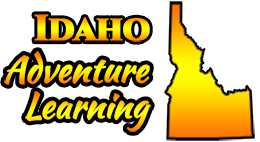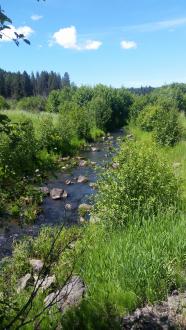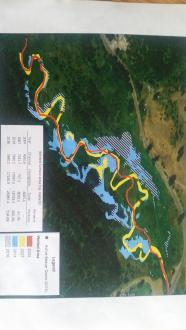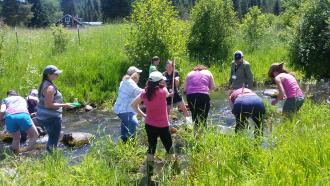Day 1: Restoring Equilibrium to Maximize Biodiversity of Benewah Creek
Submitted by Josh McKain on Mon, 2017-06-19 00:00
When you think of equilibrium, you think of a calm state of mind and a physical balance where opposing forces offset each other. Of course that is what us educators thought (early into our summer break) when we were able to explore the many reaches of Benewah Creek. Behind the scenes, drastic revitalization has occurred over the last twelve years, but there is still plenty of work for equilibrium to be restored. Stephanie Hallock, a Habitat Biologist for the Coeur d'Alene Tribe, led us through our first adventure.
The area of focus for the Benewah Creek Restoration Project is to restore the native ebb and flow of Benewah creek so West Slope Cutthroat Trout populations can be maximized and restored to pre-industrial farming and logging operations.
According to Stephanie, Benewah Creek was straightened dramatically in the early 1900’s for logging flumes. Native Cedar and Cottonwood groves were clear cut for farming and millwright operations in the area. These modifications temporarily maximized the ecological services provided by the area but decimated the ecosystems ability to maintain equilibrium and regenerate itself.
Erosion and sediment load runoff increased into Coeur d’Alene Lake due to increased water velocity. Overall water temperature increased and dissolved oxygen decreased due to decreased canopy cover over the creek. West Slope Cutthroat trout, the native species to the area, require a water temperature under 17 degrees Celsius to thrive. This has been difficult to maintain after the landscape was changed around 1908.
The Coeur d’Alene tribe and the wildlife mitigation unit have employed several practices to restore Benewah creek to its former glory so West Slope Cutthroat populations can be restored. For example:
Electrofishing is conducted continually to remove non-native brook trout that complete for resources. Deep pools, separated by shallow riffles, were created and the creek’s meandering flow was returned to its native banks. Fenced off areas with quarantined Alders have been planted to restore canopy cover.
All of this in the name of maximizing ecosystem services so that social-ecological systems and natural resources can be maintained for the future generations. Why is this important and how is it relevant to the classroom?
Today, English, Math, and Science teachers experienced firsthand how cross curricular collaboration in the field can maximize inquiry and place based education for a more vibrant learning experience. The consensus among the cohort was that by making these issues personal and relating them to the discourse that is taught, learning will become more appreciated and easier to sear into the minds of the future.
Questions to think about….
How can teachers across subject areas collaborate collectively so everyone can get into the field?
How can learning opportunities like these be presented to administration so students can get into the field?
What kinds of grants are available for funding to get students into the field?




Comments
Great Day 1 insight!
Thank you for sharing, Josh.
Benewah Creek is beautiful in photos. I have never visited, but very much enjoyed your description which allowed me to learn with you.
The restoration progress you described is very encouraging. Our Portneuf River has, too, been straightened, re-routed, and had canopy cover removed and has suffered the consequences. While the section of river in Pocatello that was reworked was for flood control purposes versus the logging at Benewah, we have experienced many of the same devastating consequences with reduced wildlife, reduced aquatic life, and poor water quality and reduced habitat. Interestingly, the sections of the Portneuf that we tested were hovering around that 17* mark and canopy cover, unfortunately, continues to be removed from our levees.
I am very excited about spending more time getting my students out in the field with a citizen-scientist's mindframe. I agree with you that real world applications and personal relatability are vital to successful lessons. Time in the field, as it did for me my week here in Pocatello and an in-person adventurer, made all the difference. What an impact! I am fortunate that my current role as a physical education teacher and a creative photography teacher teaching on a large campus with trails and trees provides me oppotunity to be outside. I am looking forward to using iNaturalist with my walking/trekking class so they can help log and identify flora and fauna on campus. I am looking forward to doing repeat photography with my photogrpahy class so we can capture and analyze changes in our campus landscape. I took the class with a colleague that teaches art and we discussed his class doing some earthworks based art and my photography class regularly photographing how the students' artwork changes as it is exposed to the outdoor elements. I have thought about coordinating a bioblitz on campus (Google National Geogrpahic BioBlitz if you are curious) or planting some native plants with our science teachers. Our English teachers bring students outside for creative writing inspiration and I know my daughter, as an 8th grader last year, kept a weather journal documenting clouds. I have also reached out to the three national parks that are geographically closest to me. They use iNaturalist and repeat photography concepts and have interpreters/rangers who are paid to coordinate with school teachers for field trips. Funding is an issue I haven't addressed yet for bigger excursions, but making a list of what trips may be available is a start. We are fortunate to be switching to 70 minutes class periods next year. I'm making a list of everything within walking distance of campus that I can put to use for mini-excursions.
Thanks again for the insight!
Biobitz and iNatural
Thamk you for sharing Darcy. I would love to have an extra 15 minutes to play with in the Science Classroom everyday. It seems like Biobitz is very similar to iNatural. What are your thoughts? I belive they are both quality apps to use in and out of the classroom. I can think of discovery exfra credit opportunities for students next year. Perhaps offer students opportunities to explore new sites and document actual visitation of said sites using apps like these? Students can present and relate inquiry, placed based excursions to what they are learning in the classroom. This would be a great substitute if it is difficult to get an entire classroom in the field.... What are your thoughts?
BioBlitz in conjunction with iNaturalist
A BioBlitz is something your class would love to do! And it can be done even in an urban setting.
During my in-person workshop here in Pocatello we performed a BioBlitz using iNaturalist as our method of record keeping. A BioBlitz is like a scavenger hunt, or in more scientific terms a biological inventory or census. We divided into two groups: terrestrial and aquatic. Each group went to a specific area with professors to guide. We were given one hour in our area and turned loose at the O'Neill Nature Preserve near McCammon, ID. During that 60 minutes it was each individual's goal to furiously observe and document as many species of flora and fauna as possible using iNaturalist. Later, when we returned to the classroom, Dr. Rick Williams reviewed all our uploaded imagery and identified each species in our photos. We then viewed our classroom statistics, including the leaderboard, to see who had taken the greatest number of photographs, who had identified the greatest number of different species, how many different species the class identified over all, etc. I don't remember my scores exactly, but I was in the top 3 in the class with over 50 observations and 30-some different species identified from my photos by Dr. Williams. It was so much fun! Some of my fellow adventurers likened it to Pokemon Go for naturalists. I took photos of all kinds of plants, found way more critters than I thought I would like flies, dragon flies, catterpillars, ants, lizards, birds, ducks, spiders, beetles, etc. I took pictures of scat from coyotes, deer, and rabbits. And I took lots of photos of beautiful, intricate flora that normally I pass right by on my outdoor hikes or during my usual outdoor fun. Read the description on National Geographic's website describing a BioBlitz in more detail (I linked it for ease).
Great Ideas!
Darcy, I love that you're having your photography class document landscape changes. I haven't heard of BioBlitz but I will have to look into that. I recently started teaching earth science--do you know if your daughter did anything like look for weather patterns associated with the clouds? Sounds like a great school!
Thanks for the awesome info and pictures Josh! Looking forward to using them in my environmental science class next year!
Weather Journal
Yes, Jennifer, they compiled a two-week weather journal where clouds were identified, temperature and precipitation were recorded, etc. I would have to ask my daughter for more details. I was most interested in her beautiful landscape/skyscape photography that she included in her journal (most kids sketched, my daughter loves photography so she asked for a rubric modification that her teacher allowed). I should have paid more attention to her content! :)
I linked BioBlitz above in my most recent response to Josh if you'd like to read a thorough description.
Cross Curriculum
Hello,
At Timberlake High School, three years ago we started our own adventure learning ecology project by taking out 150 sophomore biology students onto Spirit Lake and Brickle Creek that feeds into the lake. Our students do water quality testing in both areas, and they have had a blast doing such. The biggest thing that we are trying to accomplish right now is getting them to write papers that detail their experience and collected data. We are getting better at data analysis, however, students still struggle with their writing skills. We are going to bring in local scientists to our classrooms to show them that the writing process does not need to be some big gigantic process. Our goal is to not scare kids away from the scientific field, because of the writing process. Our english teachers have been a big help too with creating a rubric for us to grade the papers (more on content than grammar).
Even if you don't have a lake or river right now to you, you can always go out into the "playground" area and observe habitats around your school. I think just getting kids to put down their phones and observe their surroundings is huge. Maybe you can incorporate some sort of technology into it, but I prefer writing things down that I see.
My ultimate suggestion is to start small. Don't overwhelm yourself trying to incorporate everything all at once.
Science and English
A number of years ago, some of our English teachers (I am at Pocatello High School) got a grant--I don't know where it was from--to try something cross-curricular. At that time, I had a sophomore biology class that was testing our local river, so they chose to team up an English class with my class. My students learned the science behind water testing, then did all the tests. The English class came with us to the river, and had to observe, ask questions, and take notes. My students had to teach the English students about the tests they were doing, and what the results meant.
After all the testing was done and the data were analyzed, my students had to write scientific papers about the project. The English students critiqued their papers, but also had to write persuasive articles, in not-too-scientific terms, explaining to the public what was happening to our river.
Unfortunately, the next year I wasn't teaching that class any more (and our funding for field trips was cut back), so we didn't get to repeat. However, it was a great learning adventure for everyone involved!
Getting The Admin on Board
Administrator support is a difficult ball to get rolling. I have had success with inviting the administration to join us for as many activities and experiences as I can. Most times, they can't make it. However, any time they can be involved with the kids and the learning experience, they will feel more connected to making the opportunity available to students. In addition, I take video and photos when we go out. For the larger excursions, I create a video in iMovie I can put on my website and email to counselors, supporters, and administrators. For the smaller ones, I just send out a small write up that includes some student quotes and photos. The key, I think, is to include the learning objectives of the trip and the results. The videos are something I've had a lot of success with. My school district has even featured them on the website. If you have a creative kid in the class, let them take on this role. We have an exciting, interactive way to teach science here, and for it to be sustainable, administrative support is key!
Thank you Katie!
I help run the Ski and Snowboard Club at Post Falls High School!. We actually had an administrator tow the trailer once, carrying student gear, and it helped the cause. As you put it, administrators become more connected when they see learning objectives being met, and students are form connections between learning targets and the environment. Were there any release of liability forms you had to have students or parents sign in order to film these excursions?
LOVE!
Katie, I LOVE the idea of making a video and sharing to get admin support. Seems like it could be a great way to get parent buy-in too, on some of the more controversial issues. Today we talked about how difficult it can be to teach environmental topics when the community has strong industrial ties (logging, mining, agriculture, etc.).... if parents see videos of their kids getting to experience hands-on science, though, maybe there'd be more support?